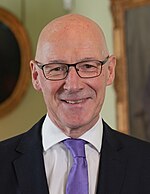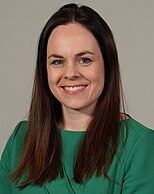|
Politics of Scotland
The politics of Scotland (Scottish Gaelic: Poilitigs na h-Alba) operate within the constitution of the United Kingdom, of which Scotland is a country. Scotland is a democracy, being represented in both the Scottish Parliament and the Parliament of the United Kingdom since the Scotland Act 1998. Most executive power is exercised by the Scottish Government, led by the first minister of Scotland, the head of government in a multi-party system. The judiciary of Scotland, dealing with Scots law, is independent of the legislature and the Scottish Government, and is headed by the Lord Advocate who is the principal legal adviser to the Scottish Government.[1] Scots law is primarily determined by the Scottish Parliament. The Scottish Government shares limited executive powers, notably over reserved matters, with the Scotland Office, a British government department led by the Secretary of State for Scotland. The Kingdom of Scotland entered a fiscal and political union with the Kingdom of England with the Acts of Union 1707, by which the Parliament of Scotland was abolished along with its English counterpart to form the Parliament of Great Britain, and from that time Scotland has been represented by members of the House of Commons in the Palace of Westminster. The Scottish Parliament was re–convened in 1999, as a result of the Scotland Act 1998 and the preceding 1997 Scottish devolution referendum, held under the Referendums (Scotland and Wales) Act 1997. The issues of Scottish nationalism and Scottish independence are prominent political issues in the early 21st century. When the Scottish National Party formed a majority government after the 2011 Scottish Parliament election and passed the Scottish Independence Referendum Act 2013, the British parliament concluded the Edinburgh Agreement with the Scottish Government, enabling the 2014 Scottish independence referendum. The referendum was held on 18 September 2014, with 55.3% voting to stay in the United Kingdom and 44.7% voting for independence. HistoryKingdom of ScotlandThe unified kingdoms of Dál Riata, Cat, Cé, Fortriu, Fib, Strathclyde, Galloway, Northumbria and the Earldom of Orkney became the Kingdom of Scotland, an independent sovereign state which existed until the signing of the Treaty of Union in 1707 with the Kingdom of England. The unified Kingdom of Scotland retained some of the ritual aspects of Pictish and Scottish kingship. These can be seen in the elaborate ritual coronation at the Stone of Scone at Scone Abbey.[2] While the Scottish monarchy in the Middle Ages was a largely itinerant institution, Scone remained one of its most important locations, with royal castles at Stirling and Perth becoming significant in the later Middle Ages before Edinburgh developed as a capital city in the second half of the 15th century.[3] The Crown was the most important element of government in the Kingdom of Scotland despite the many royal minorities. In the late Middle Ages, it saw much of the aggrandisement associated with the New Monarchs elsewhere in Europe.[4] Theories of constitutional monarchy and resistance were articulated by Scots, particularly George Buchanan, in the 16th century, but James VI of Scotland advanced the theory of the divine right of kings, and these debates were restated in subsequent reigns and crises. The court remained at the centre of political life, and in the 16th century emerged as a major centre of display and artistic patronage, until it was effectively dissolved with the Union of the Crowns in 1603.[5] The Parliament of Scotland also emerged as a major legal institution, gaining an oversight of taxation and policy.[6] By the end of the Middle Ages it was sitting almost every year, partly because of the frequent royal minorities and regencies of the period, which may have prevented it from being sidelined by the monarchy.[7] In the early modern era, Parliament was also vital to the running of the country, providing laws and taxation, but it had fluctuating fortunes and was never as central to the national life as its counterpart in England.[8] Treaty of Union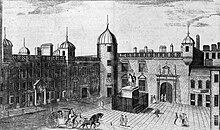 The signing of the Treaty of Union in 1707 with the Kingdom of England ended both Scotland and England's political independence, unifying both countries into a new state known as the Kingdom of Great Britain. The Parliament of Scotland, the Kingdom of Scotland's legislature situated at Parliament House, Edinburgh, was merged with the Parliament of England to establish the new Parliament of Great Britain which would be based in London.[9] Following the ratification of the Treaty of Union, Parliament House became the seat of the Supreme Courts of Scotland in which it remains today. Under the terms of the Treaty of Union, various elements of independence from England was retained for Scotland, such as a separate education and legal system (including the Scottish court system – Court of Session and High Court of Justiciary) as was the countries church and religion. Additionally, the Crown of Scotland and the Honours of Scotland were to remain in Scotland, as were all parliamentary and other official records.[9] Until 1832, Scottish politics remained very much in the control of landowners in the country, and of small cliques of merchants in the burghs. Agitation against this position through the Friends of the People Society in the 1790s met with Lord Braxfield's explicit repression on behalf of the landed interests.[10] The Scottish Reform Act 1832 rearranged the constituencies and increased the electorate from under 5,000 to 65,000.[11] The Representation of the People (Scotland) Act 1868 extended the electorate to 232,000 but with "residential qualifications peculiar to Scotland".[12] However, by 1885 around 50% of the male population had the vote, the secret ballot had become established, and the modern political era had started. Liberal and Labour Party dominanceFrom 1885 to 1918 the Liberal Party almost totally dominated Scottish politics. Only in the general election of 1931 and the general election of 1955 did the Unionist Party, together with their National Liberal and Conservative Party (UK) allies, win a majority of votes. Following the coupon election of 1918, 1922 saw the emergence of the Labour Party as a major force, and replacing the Liberals as one of the two dominant parties. Red Clydeside elected a number of Labour MPs. A Communist was elected for Motherwell in 1924, but in essence the 1920s saw a 3-way fight between Labour, the Liberals and the Unionists. The National Party of Scotland contested their first seat in 1929. It merged with the centre-right Scottish Party in 1934 to form the Scottish National Party, but the SNP remained a peripheral force until the watershed Hamilton by-election of 1967. The Communists won West Fife in 1935 and again in 1945 (Willie Gallacher) and several Glasgow Labour MPs joined the Independent Labour Party in the 1930s, often defeating the official Labour candidates by wide margins. The National Government won the vast majority of Scottish seats in 1931 and 1935. The Liberal Party, banished to the Highlands and Islands, no longer functioned as a significant force in central Scotland. In 1945, the SNP saw its first MP (Robert McIntyre) elected at the Motherwell by-election, but had little success during the following decade. The ILP members rejoined the Labour Party, and Scotland now had in effect a two-party system. DevolutionJohn Swinney, First Minister since May 2024 Kate Forbes, Deputy First Minister since May 2024 The First Minister is the head of the Scottish Government and is supported by the Deputy First Minister Devolution refers the process by which powers to legislate and govern are transferred from the UK Parliament in Westminster to a range of sub-UK level bodies, such as metro areas and the countries of the United Kingdom. Since the re–establishment of the Scottish Parliament, all matters have been devolved to that body by default, except those matters explicitly reserved to Westminster, and Westminster does not by convention legislate on devolved matters which are the responsibility of both the Scottish Parliament and Scottish Government, except by consent. In Scotland, matters devolved to the Scottish Parliament exclusively include justice and law, police and prisons, local government, health, education, housing and student support, social welfare, the economy, food safety and standards, planning policy, economic development, agriculture and rural affairs, culture, tourism, the arts and sport. A number of other matters are shared such as some elements of transport (the Scottish Government is responsible for the majority of Scotland's transportation network), public pension and taxation.[13] The Scottish Government receives a funding allocation from the UK Government, calculated under the Barnett Formula, but it does also have its own tax resources. Subsequently, the Scotland Acts of 2012 and 2016 transferred powers over some taxation including Income Tax, Land and Buildings Transaction Tax, Landfill Tax, Aggregates Levy and Air Departure Tax, drink driving limits, Scottish Parliament and local authority elections, some social security powers, the Crown Estate of Scotland, some aspects of the benefits system, some aspects of the energy network in Scotland including renewable energy, energy efficiency and onshore oil and gas licensing, some aspects of equality legislation in Scotland and gaming machine licensing.[14][15] The programmes of legislation enacted by the Scottish Parliament have seen the divergence in the provision of public services compared to the rest of the United Kingdom.[16] While the costs of a university education, and care services for the elderly are free at point of use in Scotland, fees are paid in the rest of the UK. Scotland was the first country in the UK to ban smoking in public places, with the ban effective from 26 March 2006.[17] Also, on 19 October 2017, the Scottish government announced that smacking children as punishment was to be banned in Scotland, the first nation of the UK to do so. In a further divergence from the rest of the United Kingdom from 1 January 2021 all Scottish legislation will be legally required to keep in regulatory alignment in devolved competences with future European Union law following the end of the Brexit transition period which ended on 31 December 2020 after the Scottish Parliament passed the UK Withdrawal from the European Union (Continuity) (Scotland) Act 2020 despite the United Kingdom no longer being an EU member state.[18] Future constitutional status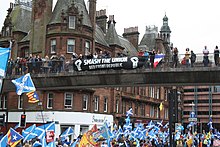  A large debate in modern Scottish politics is over the constitutional status of Scotland. One common proposal is for the independence of Scotland from the UK; this would mean Scotland would once again become a sovereign state. There was an independence referendum in 2014 in which Scottish residents voted to remain within the United Kingdom, however this debate has been reignited due to the Brexit process, with the Scottish Government calling for a second independence referendum. This position is supported by the SNP and Scottish Greens, among other groupings. Independence advocates propose that independence would resolve a democratic deficit for Scottish voters and allow Scotland to rejoin the EU. Opponents argue that Scotland would be worse off economically after independence. In 2022, the Scottish Government under First Minister of Scotland Nicola Sturgeon launched the first paper in a series of independence prospectuses entitled Building a New Scotland. The publication is a series of papers published by the Scottish Government that seeks to lay out a prospectus for Scottish independence.[19] The Scottish Government had previously proposed holding an independence referendum on 19 October 2023.[20] On 7 September 2021, Nicola Sturgeon stated that she would resume the case for independence and restart work on a prospects for independence.[21] On 13 June 2022, Nicola Sturgeon published the first independence paper.[22] On 14 July 2022, Nicola Sturgeon published the second independence paper.[23] As of March 2024, a total of ten papers had been published.[24] Other proposals include more devolution for Scotland, supported by the SNP in lieu of full independence. Under the pressure of growing support for Scottish independence, a policy of devolution had been advocated by all three GB-wide parties to some degree during their history (although Labour and the Conservatives have also at times opposed it). This question dominated the Scottish political scene in the latter half of the twentieth century with Labour leader John Smith describing the revival of a Scottish parliament as the "settled will of the Scottish people".[25] Timeline of significant events1950s
1960s
1970s
1980s and 1990s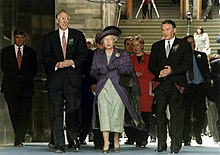
2000s
2010s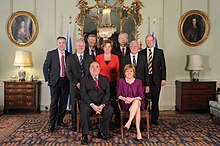

2020s
The Crown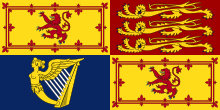 Scotland is governed under the framework of a constitutional monarchy. The head of state in Scotland is the British monarch, currently King Charles III (since 2022). Until the early 17th century, Scotland and England were entirely separate kingdoms ruled by different royal families. However, on the death of Elizabeth I of England in 1603, the then-King of Scotland James VI became James I of England, in what is known as the Union of the Crowns. However, the two monarchies remained legally separate, albeit held by the same individual.[27] Scotland is no longer an independent, sovereign country, nor is it a kingdom in its own right. Under the Union with England Act 1707, the Kingdoms of Scotland and England have been united into "One Kingdom" (Great Britain, later the United Kingdom). A unification of Scotland and England had been debated since the Union of the Crowns, however was initially met with little enthusiasm by the administrations of both countries.[27] The Crown of Scotland is still used during the monarchs first visit to Scotland following their coronation ceremony and is also present at the state opening of the Scottish Parliament alongside the remaining Honours of Scotland which the monarch attends.[28][29] Legislature There are two bodies with the power to legislate for Scotland: the Scottish Parliament and the UK Parliament. Until 1999, the UK Parliament was the source of all legislation across the whole of the UK. Since then, devolution has meant that Scotland, as well as Wales and Northern Ireland, have had independent legislatures which pass laws on devolved responsibilities. The Scottish Parliament has had the power to pass primary legislation since 1999, and passed 282 Acts between then and the end of 2018. The Scottish Parliament can legislate on anything that is not reserved to the UK Parliament.[30] The UK Parliament retains the ability to legislate on any matter for any part of the UK, including in Scotland, however since 1999 the UK Parliament has followed a convention (the Sewel convention) that means it will not normally legislate on devolved matters without the Scottish Parliament's consent.[31] Opposition parties include the Scottish Conservatives (centre-right, conservative), Scottish Labour (centre-left, social democratic), the Scottish Liberal Democrats (centrist, social liberal), and the Scottish Greens (centre-left to left-wing, green). The Scottish Socialist Party (left-wing, democratic socialist) won a seat in the first Scottish Parliament election in 1999 and increased their number of seats to 6 in the 2003 Scottish Parliament election, but then lost their seats in the 2007 election and haven't regained representation in the Scottish Parliament since. Elections were normally held once every four years from the inception of the Scottish Parliament in 1999 to 2016 (the election scheduled for 2015 was delayed for one year to 2016 after agreement by all of the main political parties). A Bill was passed by the Scottish Parliament on 25 February 2016 and received Royal Assent on 30 March 2016 increasing the term of the Parliament to five years.[32] 73 Members are elected to represent constituencies, and the remaining 56 elected via a system of proportional representation. At Westminster, Scotland is represented by 44 MPs from the Scottish National Party, six from the Conservative Party, two from the Labour Party and four from the Liberal Democrats elected in the 2019 United Kingdom general election; as well as two MPs who were elected for SNP but have since defected to the Alba Party, and a further independent. The Secretary of State for Scotland—currently Alister Jack MP, a Scottish Conservative—is usually a member of the House of Commons representing a constituency in Scotland. Scottish Government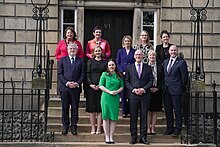 Executive power in Scotland is exercised by the Sovereign (the Monarch), split between the Scottish Government (responsible for devolved matters, including, but not limited to, education, transport, Scots law, Scottish Parliamentary and local government elections, health care, rural affairs, housing, the environment, taxation, the economy and local government). The Government of the United Kingdom retains some limited powers of Scotland, as is responsible for reserved matters, such as deference, foreign policy and security.[33] The reigning monarch formally appoints the first minister according to a nomination by the Scottish Parliament. The first minister leads the Scottish Government and appoints members to and heads the Scottish cabinet, which consists of Cabinet Secretaries, Junior Ministers, and Law Officers.[34] The Scottish Government governs through Scottish statutory instruments, a type of subordinate legislation, and is responsible for the Directorates of the Scottish Government, the executive agencies of the Scottish Government, and the other public bodies of the Scottish Government. The directorates include the Scottish Exchequer, the Economy Directorates, the Health and Social Care Directorates, and the Education, Communities and Justice Directorates.[35] Elected in the 2021 Scottish Parliament election, the centre-left pro-independence Scottish National Party (SNP) is the party which forms the devolved government; it currently holds a plurality of seats in the parliament (63 out of 129).  In August 2021, the SNP and the Scottish Greens agreed terms which would see the Scottish Greens enter into a power sharing agreement with the SNP, known as the Bute House Agreement. The agreement would see the Scottish Greens form part of the Scottish Government. The Agreement details the way in which the Scottish Government and the Green Group in Parliament will work together, the appointment of Green ministers, excluded policy areas from the Agreement, confidence and supply and dispute resolution.[36] The agreement is accompanied by a shared policy programme, which sets out in detail where the two have decided to collaborate.[37] On 31 August 2021, the SNP and Scottish Greens entered a power-sharing arrangement which resulted in the appointment of two Green MSPs as junior ministers in the government, delivery of a shared policy platform, and Green support for the government on votes of confidence and supply.[38][39] There was no agreement on oil and gas exploration, but the government now argued that it had a stronger case for a national independence referendum.[40] First Minister Humza Yousaf formally ended the Bute House Agreement on 25 April 2024, effectively removing the Scottish Greens from government. He claimed that the Bute House Agreement "had served its purpose" and would lead a minority Scottish Government.[41] As a consequence, Yousaf faces a vote of no confidence in the Scottish Parliament.[42] The first minister is conventionally the leader of the political party with the most support in the Scottish Parliament, currently John Swinney who was appointed in May 2024. Nicola Sturgeon, the previous first minister, led the government since November 2014. Before Sturgeon, Alex Salmond led the SNP to an overall majority victory in the May 2011 general election. The inaugural First Minister was Donald Dewar, the leader of Scottish Labour at the time, who was Secretary of State for Scotland at its time of establishment. First Ministers
Deputy First Ministers
International relations Scotland has a network of eight international offices across the world, these are located in:
Scottish Parliament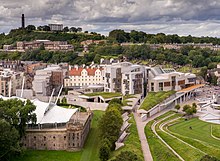  The Scottish Parliament is the national, unicameral legislature of Scotland. The election of a Labour government in the 1997 general election was followed by the Referendums (Scotland and Wales) Act 1997, which legislated for the 1997 Scottish devolution referendum, a referendum on establishing a devolved Scottish Parliament. 74.3% of voters agreed with the establishment of the Parliament and 63.5% agreed it should have tax-varying powers, which meant that it could adjust income taxes by up to 3%.[45][46] The Parliament was then established by the Scotland Act 1998. The Scottish Parliament sits in the Scottish Parliament Building at Holyrood in Edinburgh, giving it the informal name "Holyrood". In the Scottish Parliament, the inhabitants of Scotland are represented by 129 members of the Scottish Parliament (MSPs), who are elected by the additional member system, a form of proportional representation, by the Scottish Parliament constituencies and electoral regions. Thus the Parliament is unlike the UK Parliament, which is elected solely by the first past the post method. Of the 129 MSPs, 73 are elected to represent first past the post constituencies, whilst the remaining 56 are elected by the additional member system from eight regional lists. In the present parliament, elected in the 2021 Scottish Parliament elections, all MSPs are members of a political party and no independents. It enacts primary legislation through Acts of the Scottish Parliament, but cannot legislate on reserved matters, as set out by the Scotland Act 1998 and amended by the Scotland Act 2012 and the Scotland Act 2016; these include defence, international relations, fiscal and economic policy, drugs law and broadcasting. Anything not mentioned as a specific reserved matter is automatically devolved to Scotland, including health, education, local government, Scots law and all other issues. This is one of the key differences between the successful Scotland Act 1998 and the failed Scotland Act 1978. The Presiding Officer of the Scottish Parliament is the speaker of the parliament and the ex officio head of the Scottish Parliamentary Corporate Body.[47] The Presiding Officers of the Scottish Parliament have been:
Scots Law and JudiciaryThe Courts of Scotland administer justice in Scots law, the legal system in Scotland. The Lord Advocate is the chief legal officer of the Scottish Government and the Crown in Scotland for both civil and criminal matters for which Scottish Parliament has devolved responsibilities. The Lord Advocate is the chief public prosecutor for Scotland and all prosecutions on indictment are conducted by the Crown Office and Procurator Fiscal Service, nominally in the Lord Advocate's name. The Lord Advocate's deputy, the Solicitor General for Scotland, advises the Scottish Government on legal matters. The Advocate General for Scotland advises the British Government, and leads the Office of the Advocate General for Scotland, a British government department. The High Court of Justiciary is the superior criminal court of Scotland. The Court of Session is the highest civil court and is both a court of first instance and a court of appeal. For judicial purposes, Scotland has been divided into six sheriffdoms with sheriff courts since the reform of the Local Government (Scotland) Act 1973. Appeals from the Court of Session are made to the Supreme Court of the United Kingdom, which is also the final authority for constitutional affairs. Scotland in the United Kingdom Secretary of State for ScotlandScotland is one of the four countries of the United Kingdom. Scottish reserved affairs (powers not controlled by the Scottish Parliament and Scottish Government) are managed by the Secretary of State for Scotland, a role which aims to "promote the best interests of Scotland within a stronger United Kingdom" and represent Scottish interests within the UK government.[48] However, the Secretary of State is normally appointed by the UK Government and is from the government parties, not necessarily from the major party in Scotland. The current Secretary of State for Scotland is Iain Murray who was appointed to the role in July 2024.[49] Statutory instruments made by the UK Government – within which the Secretary of State for Scotland is a member of the Cabinet of the United Kingdom – may also apply to the whole of Great Britain. The Secretary of State for Scotland is appointed by the Prime Minister of the United Kingdom. This Secretary of State, who prior to devolution headed the system of government in Scotland, sits in the Cabinet of the United Kingdom and is responsible for the limited number of powers the office retains since devolution, as well as relations with other Whitehall Ministers who have power over reserved matters. The Scotland Office is a department of the Government of the United Kingdom, responsible for reserved Scottish affairs. The Scotland Office, created in 1999, liaises with other Whitehall departments about reserved matters. Before devolution and the Scotland Office, much of the role of the devolved Scottish Government was undertaken by the Scottish Office, the previous British ministerial department led by Scottish Secretary. Parliament of the United KingdomScotland is represented by 57 MPs in the House of Commons of the United Kingdom elected from territory-based Scottish constituencies, out of a total of 650 MPs in the House of Commons. Various members of the House of Lords represent Scottish political parties. The co-existence of devolution for Scotland and its continued representation in the UK Parliament, which retains full powers over matters relating to England, raised a debate known as the West Lothian question. This questions whether Scottish (and other devolved nation) representatives should continue to have a vote on affairs that do not relate directly to Scotland. This issue was exemplified in the raise in tuition fees in England in 2004. If non-English MPs, who were mostly government MPs, had not been able to vote, then the tuition fee rise would not have been able to occur, due to a rebellion on the government benches.[50] This led to the creation in 2015 of the English votes for English laws (EVEL) process, in which Scottish MPs were not included in parts of the lawmaking process for laws that did not apply in Scotland. EVEL was abolished 2021. Scottish representation in the Commons
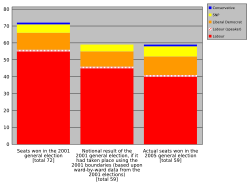 For UK general elections, Scotland is divided into 59 constituencies of broadly equal population by the Scottish Boundary Commission. Each constituency elects a single Member of Parliament (MP), who represents the constituency in the House of Commons alongside representatives from the other countries of the UK. There are 650 MPs in total. The leader of the party or coalition that makes a majority or plurality in the Commons is typically invited by the reigning monarch to become the Prime Minister and to form a government. Since 1945, Scottish seats have altered the final result of a general election four times. Without Scottish seats: in 1964, the Conservatives would have been the largest party rather than Labour; in February 1974, the Conservatives would have been the largest party but without a majority rather than Labour; in October 1974, Labour would no longer have won its majority and in 2010, the Conservatives would have won an outright majority and would not have needed to form a coalition with the Liberal Democrats.[52] Until the 2005 general election, Scotland elected 72 MPs from 72 single-member constituencies to serve in the House of Commons. As this over-represented Scotland in comparison to the other parts of the UK, Clause 81 of the Scotland Act 1998 equalised the English and Scottish electoral quota. As a result, the Boundary Commission for Scotland's recommendations were adopted, reducing Scottish representation in the House of Commons to 59 MPs with effect from the 2005 general election. The necessary amendment to the Scotland Act 1998, was passed by the Parliament of the United Kingdom as the Scottish Parliament (Constituencies) Act 2004. As of the 2024, the current representation of Scottish seats in the Commons, according to party allegiance, is:
Historic representation
Scottish LordsIn 2015, twelve of the 92 hereditary peers with seats in the House of Lords to which they are elected (from among themselves) under the House of Lords Act 1999 were registered as living in Scotland, as were 49 life peers appointed under the Life Peerages Act 1958, including five former Lords Advocate.[53] James Thorne Erskine, 14th Earl of Mar and 16th Earl of Kellie, retired in 2017 having lost his seat as a hereditary peer in 1999 but regained it in 2000 as a life peer; Charles Lyell, 3rd Baron Lyell (former Under-Secretary of State for Northern Ireland) died the same year. One of the former Lords Advocate, Kenneth Cameron, Baron Cameron of Lochbroom, retired from the Lords in 2016, while another, Donald Mackay, Baron Mackay of Drumadoon died in 2018. Besides these 61 peers listed in 2015 are hereditary members of the Lords living outwith Scotland, but who have titles in the Peerage of Scotland, such as Margaret of Mar, 31st Countess of Mar, or Scottish titles in the peerages of Great Britain or of the United Kingdom.[53] Apart from these, there are also Scottish life peers with titles associated with places outside Scotland, such as Michelle Mone, Baroness Mone of Mayfair.[53] Political appointees include: Former Lords Advocate include:[53]
Scottish hereditary peers include:
Between the Acts of Union 1707 and the Peerage Act 1963, peers with titles in the Peerage of Scotland were entitled to elect sixteen representative peers to the House of Lords. Between the 1963 Act and the House of Lords Act 1999 the entire hereditary Peerage of Scotland was entitled to sit in the House of Lords, alongside those with titles in the peerages of England, of Ireland, of Great Britain, and of the UK. Local government For the purposes of local government in Scotland, the country has been divided into 32 council areas since the Local Government etc. (Scotland) Act 1994. Since the Local Government (Scotland) Act 1973, which also abolished the shires of Scotland, the country has been subdivided into community councils. Though retained for statistical purposes, the civil parishes in Scotland were abolished for administrative purposes in the Local Government (Scotland) Act 1929. Local government in Scotland is organised into 32 unitary authorities. Each local authority is governed by a council consisting of elected councillors, who are elected every five years by registered voters in each of the council areas. Scottish councils co-operate through, and are represented collectively by, the Convention of Scottish Local Authorities (COSLA). There are currently 1,227 councillors in total, each paid a part-time salary for the undertaking of their duties. Each authority elects a Convener or Provost to chair meetings of the authority's council and act as a figurehead for the area. The four main cities of Scotland, Glasgow, Edinburgh, Aberdeen and Dundee have a Lord Provost who is also, ex officio, Lord Lieutenant for that city. There are in total 32 councils, the largest being the Glasgow City Council with more than 600,000 inhabitants, the smallest, Orkney Islands Council, with fewer than 20,000 people. See Subdivisions of Scotland for a list of the council areas. The most recent local elections in Scotland were held in 2022 and the next local elections are scheduled for 2027. Community councilsCommunity councils represent the interests of local people. Local authorities have a statutory duty to consult community councils on planning, development and other issues directly affecting that local community. However, the community council has no direct say in the delivery of services. In many areas they do not function at all, but some work very effectively at improving their local area.[54] Political partiesScottish National Party (SNP): The current party forming the Scottish Government is the Scottish National Party (SNP), which won 64 of 129 seats available in the 2021 Scottish Parliament election and 44.2% of the vote, one more seat than in 2016.[55] The SNP was formed in 1934 with the aim of restoring Scottish independence.[56] They are broadly centre-left and are in the European social-democratic mould. They are the largest party in the Scottish Parliament and have formed the Scottish Government since the 2007 Scottish Parliament election. Scottish Conservatives and Unionist Party: The Unionist Party was allied with the UK Conservative Party until 1965, when the Scottish Conservative and Unionist Party was formed. The Conservatives then entered a long-term decline in Scotland, culminating in their failure to win any Scottish seats in the 1997 UK election.[57] At the four subsequent UK elections (2001, 2005, 2010 and 2015) the Conservatives won only one Scottish seat.[58][59][60][61] The party enjoyed a revival of fortunes in the 2016 Scottish Parliament election, winning 31 seats and finishing in second place. In the 2021 Scottish Parliament elections, they got 22.8% of the vote, winning 31 seats again.[62] The Conservatives are a centre-right party. Scottish Labour Party: In the course of the twentieth century, Scottish Labour rose to prominence as Scotland's main political force.[63] The party was established to represent the interests of workers and trade unionists. From 1999 to 2007, they operated as the senior partners in a coalition Scottish Executive. They lost power in 2007 when the SNP won a plurality of seats and entered a period of dramatic decline,[64] losing all but one of their seats in the 2015 UK election[65] and falling to third place in the 2016 Scottish election.[66] The 2017 UK election produced a mixed result for the party as it gained six seat and increased its vote by 2.8% but the party came in third behind the SNP and Scottish Conservatives. In the 2021 Scottish Parliament elections, they got 19.8% of the vote, winning 22 seats.[62] Liberal Democrats: The Scottish Liberal Democrats were the junior partners in the 1999 to 2007 coalition Scottish Executive. The party has lost much of its electoral presence in Scotland since the UK Liberal Democrats entered into a coalition government with the UK Conservative Party in 2010. In the 2015 UK election they were reduced from 12 seats to one seat, and since the 2016 Scottish Parliament election they have had the fifth highest number of MSPs (five), unchanged on 2011.In the 2021 Scottish Parliament elections, they got 6% of the vote, winning 4 seats.[62] Scottish Green Party: The Scottish Greens have won regional additional member seats in every Scottish Parliament election, as a result of the proportional representation electoral system. They won one MSP in 1999, increased their total to seven at the 2003 election but saw this drop back to two at the 2007 election. They retained two seats at the 2011 election, then increased this total to six in the 2016 election. In the 2021 Scottish Parliament election they increased their representation by two seats to a total of eight members of the Scottish Parliament, however this was lowered to 7 a week later after Alison Johnson became Holyrood's Presiding Officer, a neutral role meaning she had to give up her position as a Green MSP).[62] The Greens support Scottish independence and Scottish republicanism, and in 2021, entered into a power sharing agreement with the Scottish National Party.[67] Known as the Bute House Agreement, it was agreed in August 2021 to support the Third Sturgeon government, and saw two Scottish Green politicians appointed to junior ministerial posts within the Scottish Government. First was the first time any Green politician had served in government in Scotland and across the United Kingdom.[68] The Scottish Greens left the Scottish Government on 25 April 2024, following First Minister Humza Yousaf's announcement of the ending of the Bute House Agreement "with immediate effect".[69] The Scottish Green Party later confirmed it would "vote to oust" Yousaf as First Minister.[70] See also
Notes
References
External links
|
||||||||||||||||||||||||||||||||||||||||||||||||||||||||||||||||||||||||||||||||||||||||||||||||||||||||||||||||||||||||||||||||||||||||||||||||||||||||||||||||||||||||||||||||||||||||||||||||||||||||||||||||||||||||||||||||||||||||||||||||||||||||||||||||||||||||||||||||||||||||||||||||||||||||||||||||||||||||||||||


